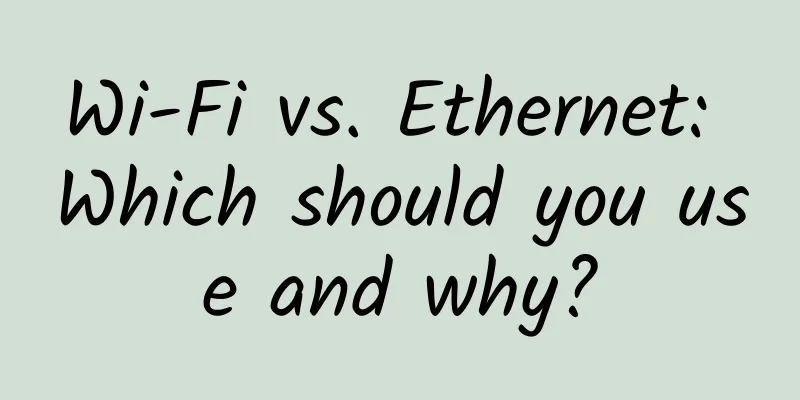Wi-Fi vs. Ethernet: Which should you use and why?

|
Not long ago, you had to choose between a wired or wireless setup for your home Internet, online gaming, and all other web-based activities. But now it's clear: Wi-Fi is the obvious choice. Is this really the case? Is Ethernet really dead? Or does good old-fashioned cable connections still have their place in the modern tech world? Let's take a look. Ethernet vs. Wi-Fi: Key DifferencesUntil a few years ago, the choice between Ethernet and Wi-Fi was pretty straightforward. Ethernet is much faster, but because it requires wiring, you are severely limited in where you can place your computers in relation to your router. Once you've chosen a spot, you can't move it around. Wi-Fi, on the other hand, is a bit slower but conveniently available within a range of 150 feet from the router. Wi-Fi hotspots can be found in many places. It works with a wider range of devices, including phones and tablets. That's the choice: speed versus convenience. As a result, the two are often viewed as complementary rather than opposing technologies. But Wi-Fi continues to improve, becoming faster and more reliable, and as a result, Ethernet is being squeezed further out of the market. speedWhen Wi-Fi first became mainstream, it was largely based on the 802.11g standard (which would be known as Wi-Fi 3 under modern naming conventions.) This offered a maximum theoretical speed of 54Mbps (megabits per second), which was much lower in practice. It's fast enough to access the internet on a mobile device, but it's nowhere near the performance offered by Ethernet, which has speeds between 100Mbps and 1000Mbps, with a maximum of 10gb/second. The latest Wi-Fi standard is Wi-Fi 6, which offers theoretical speeds of up to 10Gbps (real-world speeds are about half that). That’s well ahead of most typical home broadband connections — the average internet speed in a U.S. home is said to be a little over 100Mbps. Assuming you have the hardware to support this standard (your router and all your devices need it), it means your broadband speed will be the bottleneck, not your Wi-Fi speed. Even if you're using slightly older technology, it's still fast - Wi-Fi 5 offers theoretical speeds of up to 3.5Gbps. In both cases, they offer less latency (lower delay or ping rate) than past wireless technologies, making it increasingly suitable for gaming. The main advantage of Ethernet is now gone, and you can even test it yourself. Go to a site like speedtest.net and test your internet speed using Wi-Fi and then Ethernet (make sure to turn off Wi-Fi before doing the second test) and compare the results. If the results aren't what you hoped for, there are even some simple steps you can take to increase your Wi-Fi speed. reliabilityHowever, all speeds are theoretical. A fixed Ethernet connection may be fast, stable, and provide consistent speeds. If you download large files or stream a lot of 4K video, you’ll notice the benefits. Wi-Fi is susceptible to countless environmental factors. Radio waves can be blocked by walls and floors. Other wireless devices can interfere with the signal, including things you wouldn't expect, like microwaves and cordless phones, as well as nearby routers using the same channel. Even the atmosphere can cause problems. Newer standards have less interference, but you can still get inconsistent performance on Wi-Fi. As you move around your home, you can see the strength of your Wi-Fi network connection drop and rise, affecting speeds accordingly. You may even have dead spots in your home where the Wi-Fi signal simply doesn't reach. You can minimise this by making sure your router is placed in the best spot in your home, but you're unlikely to achieve the same level of consistent performance as you would with Ethernet. Number of devicesWhile Wi-Fi 5 and Wi-Fi 6 offer top speeds comparable to what you’d get from Ethernet, they’re unlikely to provide noticeably faster speeds on a single device. The main benefit of the increased performance is that you can connect more devices without slowing down any of them. You can do the same with Ethernet, of course, but even most laptops these days don't have Ethernet ports built in. In most cases, you'll be limited to desktop PCs and gaming consoles, both of which will require cabling. Or you can set up a powerline network to help. SafetySecurity is another important factor when comparing Wi-Fi and Ethernet. Here, there is no comparison. Data on an Ethernet network can only be accessed by devices that are physically connected to the network. These devices, including PCs on one end and routers on the other, require firewalls to protect them, but the data itself cannot be intercepted on the network. With Wi-Fi, data is in the air. If you're using an open network in a public place (which you shouldn't be doing), then all the data you send and receive can be intercepted, including personal information and login details. Most Wi-Fi networks are secure, so your data is encrypted. But the strength of the encryption depends on the security method you use. Most routers offer a range of security modes. WEP is the least secure and should be avoided whenever possible. WPA3 is the most secure wireless security option, and WPA2 is good enough if you have a router that offers it. For added security, you should also change the default Wi-Fi username and password in the admin panel on your wireless router. The default settings can be easily found online and can allow others to access your network without your knowledge. Making the Right Choice: Ethernet vs. Wi-FiSo, when should you choose Ethernet over Wi-Fi? For most people and most use cases, there's no reason not to use Wi-Fi. If you're using reasonably modern hardware, you'll get good speeds and reliable performance, and the convenience of wireless will far outweigh any remaining advantages of a wired connection. The main reason you should opt for a wired connection is if you're a serious gamer and your console or PC can't get a consistently fast connection, or the latency is too high. Of course, you don't have to choose between the two. Wireless routers usually have Ethernet ports, so you can decide whether to connect wired or not, depending on your specific devices. |
<<: Sharing of practical experience on routing technology pitfalls, have you learned it?
>>: PoE Troubleshooting Guide: Common Problems and Solutions
Recommend
South Korea: 14 6G communication satellites will be launched before 2031
June 21 news, according to foreign media reports,...
Gartner: Low-code will continue to grow in 2021
[[383502]] Industry data: Forrester predicts that...
Leading products and fast delivery: H3C helps Jomtel Mexico cope with digital challenges
Currently, in the digital trend sweeping the worl...
Practice on optimizing VUA forwarding performance of vivo unified access gateway
VLB stands for vivo load balance. As the IDC traf...
The era of ubiquitous smart devices and edge computing is coming
Edge computing is on the rise. Are you ready for ...
my country's total 5G base stations account for more than 60% of the world's total
The 2021 Communications Industry Statistical Bull...
China Mobile's TD-SCDMA network withdrawal begins: Fujian has taken the lead
[[259267]] Recently, the Fuzhou Radio Management ...
Let's talk about short links
Introduction I am working on a promotion system r...
The Ministry of Industry and Information Technology issued an urgent warning: fraud using "number portability" has been launched
On December 6, the Ministry of Industry and Infor...
Aruba Named a Leader in Gartner Magic Quadrant for Enterprise Wired and Wireless LAN Infrastructure for Sixteenth Consecutive Year
Beijing - November 30, 2021 – Aruba, a Hewlett Pa...
80VPS: VPS hosting starts at 199 yuan per year, with options for Los Angeles/Hong Kong CN2/Japan CN2/Korea BGP, etc.
We have shared the information of the cluster ser...
Review and Outlook of China's 100-day 5G Licensing
Since June 6, when the Ministry of Industry and I...
Huawei's Meng Wanzhou: 5.5G is the inevitable path for 5G network evolution
On June 28, 2023 MWC Shanghai opened, and Huawei ...
Yecao Cloud: Hong Kong special cloud server annual payment starts from 138 yuan, independent server monthly payment starts from 399 yuan
Yecaoyun, a Chinese VPS host, has released a new ...
The legend of network protocols (Part 2): TCP emerges
This section will formally enter the content of n...









